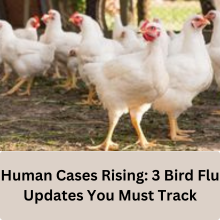The world is keeping a close eye on avian influenza (bird flu), particularly the H5N1 strain, due to its potential to spark a human pandemic. Over the past few months, a number of concerning developments have raised alarms about the spread of this virus among humans. In this article, we’ll explore three key trends that are increasing the level of concern and why they warrant close attention in the coming weeks.
1. Undiagnosed Human Cases of Bird Flu
The CDC’s Study on Dairy Farm Workers
In an unsettling revelation, a study published by the Centers for Disease Control and Prevention (CDC) found that a significant number of human cases of bird flu were likely going undiagnosed. The study focused on dairy farm workers who were in close contact with poultry during outbreaks of H5N1. It found that 7% of workers at farms with active outbreaks showed signs of recent infection, yet none had been diagnosed while actively sick.
The Issue of Limited Testing
This study suggests that many human cases might be undetected due to limited testing capabilities. Public health experts have long suspected that the true scale of human infections could be far greater than currently reported. What’s concerning is that half of the workers who showed evidence of infection did not remember having any symptoms. For the others, symptoms were mild or not reported, which makes it harder to detect and diagnose the infection in time.
The CDC’s Response to New Findings
The CDC responded by changing its guidelines, recommending that asymptomatic workers in high-risk settings be tested for the virus. They also advocated for the use of antivirals to reduce the likelihood of developing severe symptoms or spreading the virus. The CDC has signaled that as testing ramps up, the number of reported cases is likely to rise. This could offer a clearer picture of how widely H5N1 has already spread among humans.
What This Means for Human-to-Human Transmission
One of the key takeaways from this development is the potential for human-to-human transmission. While the primary source of infection has been animals, including poultry, this new trend of undiagnosed cases raises questions about how easily the virus might spread between humans. Expanded testing, particularly for family members of exposed workers, could offer critical insights into whether human-to-human transmission is occurring on a larger scale.
2. New Cases with No Known Exposure to Farm Animals
The Missouri Case: A Worrying Trend
In Missouri, a patient was found to have contracted H5N1 while hospitalized for a separate issue, despite having no known contact with farm animals. This case is troubling because it challenges the traditional understanding that bird flu transmission primarily occurs through close contact with infected animals. To make matters more alarming, another person in the patient’s household also tested positive for the virus, but the source of their infection remained unclear.
The Canadian Case: A Teenager’s Critical Illness
In Canada, the first human case of avian flu involved a teenager who was reported to be critically ill. Again, this case is concerning because the teen had no direct contact with poultry or farm animals. The source of infection remains unknown, and this uncertainty is fueling fears that the virus might be mutating in ways that make it more capable of spreading among humans.
Also read: St. Louis Snowstorm Saturday: 5 Inches Expected—Prepare Now
Genetic Mutations in H5N1 Strain
Genetic sequencing of the virus from the Canadian teen revealed mutations that suggest the virus might be evolving to become better at infecting humans. While these mutations do not yet suggest an imminent pandemic, the possibility of further mutations makes it important to track any new cases closely. Mutations could lead to a situation where the virus becomes more transmissible, raising the risk of a larger outbreak.
The Importance of Tracking Unusual Cases
Cases like those in Missouri and Canada underscore the importance of tracking and investigating human cases that don’t follow the typical pattern of exposure. These developments highlight the possibility of new pathways for transmission, whether through other animals or even through human-to-human spread. Public health authorities must continue to investigate these cases to prevent a broader outbreak.
3. Potential Changes in U.S. Leadership and Policy
The Biden Administration’s Handling of Bird Flu
The Biden administration has taken some crucial steps to prepare for the potential spread of H5N1. This includes funding vaccine manufacturers to ensure that millions of doses are available in case the virus becomes more widespread. However, critics argue that the response has been slow in some areas, particularly regarding the widespread availability of tests and vaccines.
What to Expect from the Incoming Administration
On January 20, a new administration will take office, and with it, a shift in how public health responses are managed. President-elect Donald Trump’s potential appointee for the Department of Health and Human Services (HHS), Robert F. Kennedy Jr., has a controversial track record on vaccine policy. Kennedy is known for his anti-vaccine stance, which could hinder effective action against H5N1 if he assumes the position.
The Need for Immediate Action
As the transition of power nears, it is critical that the outgoing administration takes further steps to protect public health. This includes pushing the Food and Drug Administration (FDA) to approve vaccines for H5N1 and making sure that testing kits are distributed to high-risk areas. Failure to take swift action could put the public at greater risk, especially if the incoming administration decides to delay or reverse these efforts.
What the CDC and FDA Should Do Now
The CDC must continue to lead in terms of research and public health recommendations. It should also ensure that rapid diagnostic tests are more widely available to identify H5N1 infections early, especially in high-risk settings like farms and hospitals. Additionally, expanding access to antivirals could reduce the chances of severe illness or transmission.
Also read: Is Trader Joe’s Open on Thanksgiving? Find Out Now
Conclusion
The recent developments in the spread of H5N1 bird flu among humans are a cause for concern. While the virus has not yet reached pandemic levels, the signs are there that it is evolving and spreading in new ways. More human cases are likely to be diagnosed as testing expands, and the potential for human-to-human transmission cannot be ruled out.
It is crucial that public health agencies, governments, and international organizations stay vigilant and responsive. Enhanced testing, vaccine readiness, and close monitoring of new cases will be key to preventing a larger-scale outbreak. We must also ensure that leadership transitions in the U.S. do not hinder the ongoing efforts to protect public health. The coming weeks and months will be crucial in determining how the world responds to the growing threat of bird flu.
FAQs
What is H5N1 bird flu, and why is it a concern for humans?
H5N1 is a strain of avian influenza that primarily affects birds. However, it has infected humans in rare cases. It is concerning because of its potential to mutate and spread more easily among humans, which could lead to a pandemic.
Why are some human cases of bird flu going undiagnosed?
Limited testing and mild symptoms in many infected individuals are causing some cases to go unnoticed. Many people who test positive for H5N1 do not remember having any symptoms, making diagnosis difficult.
Can bird flu be transmitted from human to human?
While human-to-human transmission of H5N1 is rare, recent cases have raised concerns that the virus may be evolving to become more capable of spreading between humans.
What steps are being taken to prevent a bird flu pandemic?
Public health authorities are ramping up testing, developing vaccines, and ensuring that antiviral medications are available. Additionally, monitoring for mutations in the virus is crucial to understanding its potential to spread.
How does the U.S. administration plan to handle the bird flu threat?
The Biden administration has taken steps to ensure vaccine availability and testing, but concerns remain about the speed and effectiveness of these measures. The incoming administration’s approach, especially with a potential anti-vaccine leader, is another factor that will impact the response.


